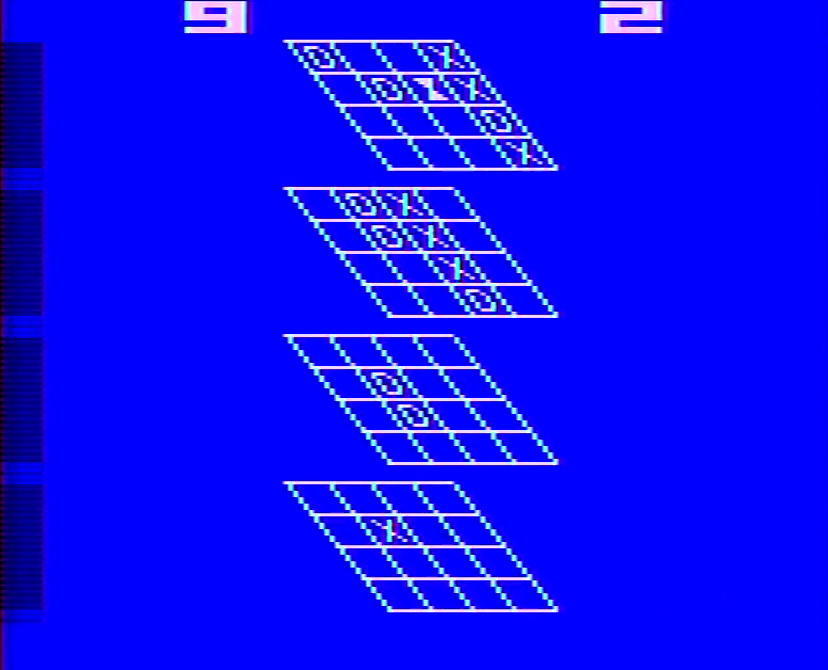
3-D Tic-Tac-Toe, by Carol Shaw – yes, the same Carol Shaw who would write seminal classic River Raid – is in some ways the most ambitious of the four games Atari published in July 1980 – a group that includes Night Driver, Golf, and Circus Atari – though it certainly doesn’t seem like it at first glance.

Tic-tac-toe is, by itself, an incredibly ancient game dating back to the Egyptian Empire where players take turns trying to make a three-in-a-row line of either Xs or Os. Barring that, the players want to prevent their opponent from doing so and forcing a draw; as such a winning strategy involves positioning your characters in such a way where you can win in more than one way on your next turn. The game’s modern form dates back to the mid-1800s as “noughts and crosses” in England, and very likely nearly everyone alive today has played some form of it in their lives. Tic-tac-toe and its variants were very early targets for computer systems and game consoles, too. Bertie the Brain was a specialized tic-tac-toe playing machine built for the 1950 Canadian National Exhibition, ostensibly to show off a miniaturized vacuum tube. A few years later, a version programmed for the EDSAC computer at the University of Cambridge known later as OXO was written by A.S. Douglas as part of a thesis on human-computer interaction; the player would input their move using a rotary telephone dial and the computer would update the screen when a move had been made. As computers moved away from the mainframe era into the minicomputers of the 1960s and 70s, tic-tac-toe made the trip as well. A tic-tac-toe program was written for the TX-0 computer at MIT for fun by members of the Tech Model Railroad Club – the same club whose members would go on to create Spacewar! – while another was written for the IBM 705 and was included in the April 1962 catalog of programs. Two versions of tic-tac-toe unsurprisingly also found their way into David Ahl’s 101 BASIC Computer Games book collection. Computer gaming pioneer Joe Weisbecker even wrote a version of the game for his FRED prototype computer in 1971 that saw one player going up against the computer, using the machine’s hex keypad for move entry… yet one of his earliest forays into computers included building an analog tic-tac-toe machine in the early 1950s.
When game consoles came along, tic-tac-toe followed. A version of the game was created for Project RAVEN in the mid-70s, Alpex’s programmable game prototype that would go on to be picked up by Fairchild and turned into the Channel F; Fairchild engineer Jerry Lawson remarked in a 2004 Classic Gaming Expo appearance that the infamous “you lose turkey” phrase in the game was added in as a joke by the developer given Lawson’s love of the word “turkey” at the time. Versions of the game for the APF MP1000 and Bally’s Professional Arcade consoles were released in 1978 and 1979 respectively, but functionally they aren’t all that different from Fairchild’s. The Odyssey2’s European counterpart, the Videopac, got a two-player specific version of Noughts and Crosses with the unique mechanic of being able to pick up and re-place your own symbols until there is a winner. Shaw and Atari’s version was something a little bit different from all of these, however, by bringing the Z axis into play.

The origins of 3-D Tic-Tac-Toe are a bit more obscure than its traditional counterpart, but it also saw computerized versions – the first one was produced for the IBM 650 mainframe computer and available in the same program catalog from 1962 as regular tic-tac-toe, and unsurprisingly David Ahl collected 3-D Tic-Tac-Toe in his BASIC book as well. Functionally the game’s goal is the same as regular tic-tac-toe: the players want to get either three or four of their objects in a row, depending on the size of the playing field. The 3D comes in as this is no longer just a single plane to work with – this game is played in either 3x3x3 or 4x4x4 layouts, with multiple planes stacked on top of one another. As a result, there are a lot more routes to victory to keep in mind, as your winning lines can be horizontal, vertical, or diagonal in either orientation. Commercially Parker Brothers started selling 3D tic-tac-toe under the name Qubic in 1964, and it would be this version that seemingly inspired Shaw to write her own version.
This wouldn’t be Shaw’s first time working with the VCS, even though it was her first published game. Shaw joined the company in August 1978, with a background in computers dating back to her high school days, where she was exposed early on to BASIC and computer games before going to UC Berkley for computer science. Shaw joined the company shortly after getting her Masters in computer science as a microprocessor software developer; while she interviewed at a few companies, she remarked in an in-depth 2011 interview with historian Benj Edwards that she liked the idea of being played to play games, having played early coin-op titles such as Computer Space and Pong at a local miniature golf course and Star Trek at high school. At the time she was hired into Atari, she was the company’s sole female game designer on the consumer side of the company; Shaw said she was kind of used to that situation already from being one of the few women in her computer science courses, and remarked that the other game designers didn’t discriminate against her. That said, she told Edwards that Atari CEO Ray Kassar did make a sexist comment after her hire, that as a woman she could do “cosmetic color matching and interior decorating cartridges,” two subjects she had little interest in. The other designers reassured her that she could do whatever she felt like, and to just ignore Kassar. Among the developers, she would gain a reputation while there as a master of the 6502 microprocessor, particularly with developing the game “kernels” used to build out the display of VCS games.
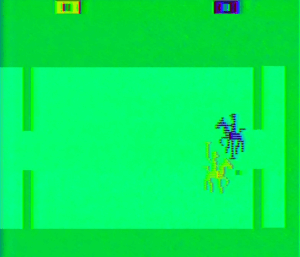
Her first job with Atari was to write a tie-in game for Ralph Lauren’s Polo cologne – Ralph Lauren being owned by Warner, as was Atari. The idea was to introduce the game in the Bloomingdale Department Store in New York in March 1979, around when the cologne was coming out, Shaw said. Given the cologne’s name, Shaw wrote up one of the only examples of the polo sport to ever grace a video game console. This title, for one or two players, saw people on horseback trying to knock a ball into their respective goals using a mallet that swings automatically every few moments. The game featured 24 game types, adjusting ball speed, whether or not it rebounds or wraparounds the sides, how large the goals are, and whether or not players control one or two horses per side. Despite producing a few prototypes and instructions for the game, and the enthusiasm on the part of Ralph Lauren to include it in its March 1979 promotional plans, Polo never ended up being sold widely until decades later, when it was included with permission on the Stella Gets a New Brain CD in 1996. In all, Polo took her about two or three months to finish, with the final version dated Dec. 6, 1978; she appears to have started her next project the following January. This was a VCS conversion of Qubic, which took her about six months to complete.
While Shaw didn’t quite remember how she hit on the idea of making 3-D Tic Tac Toe as a cartridge game, she mentioned to Edwards that creating a computer opponent seemed like an interesting challenge, especially within 2 kilobytes of cartridge space. Her partner Ralph Merkle, a computer science engineer in his own right, had gotten a paper from author Oren Patashnik that weakly solved the game by indicating that the four outside corners could always be used to get the first player a victory, but this used a full table lookup to determine each move. This wasn’t an option on the 2k cart Shaw was working with, so she instead opted for a simple tree search that would look ahead between one and eight moves. How many moves ahead is dependent on the difficulty level, with each higher difficulty adding a new level of look ahead and lengthening the process, starting at half a second on level 1 up to 20 minutes at level 8. Due to limited memory and computing power, the VCS will blank the screen while considering its next move. To keep the computer from always playing the same way, however, she added an element of randomness to its decision-making. Carol Shaw’s papers at the Strong Museum of Play indicate she also got an offer of help from Atari coin-op developer Ed Logg, who had written a 3-D Tic-Tac-Toe game for minicomputers such as the CDC 6000 and IBM 360/370, but there’s no indication she took him up on the offer. She did write a response letter to Patashnik about his Qubic paper, informing him that she pitted her version of the game up against the Unix version he used, with her VCS version successfully winning when starting first and forcing it into a draw when starting second.
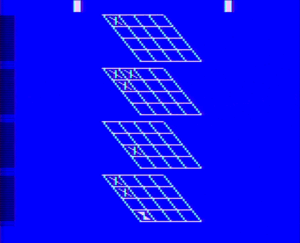
To her credit, the computer opponent in this game is brutal, even at the lowest difficulty level. 3-D Tic-Tac-Toe only takes a little longer than its regular counterpart to run through a match, but unless you know some particularly good strategies in this game the computer is exceptionally good at capitalizing on your decisions. Furthermore, the perspective used on this cart can make it easy to miss some otherwise clear diagonal moves the computer makes. You really have to keep your eyes open and formulate your game plan no matter what. This is especially true on higher difficulty levels, where the computer will absolutely steamroll you if you don’t know what you’re doing. Part of this stems from the game defaulting to letting the computer (or player two) go first. Flipping the right difficulty switch will allow player one to get the first move, which, as in regular tic tac toe, makes a huge difference in strategy and how likely it is for the first player to win. And similar to both Backgammon and Video Chess, the left difficulty switch puts the game in a “set up” mode, where you can pre-select squares for either Xs or Os to have filled already. Flipping it back will get the game rolling with your arrangement. This is a nice way to practice specific setups, or to just get a hollow victory over the computer after it’s beaten you five matches straight. The cart also includes a two player mode, but weirdly this still involves the screen blanking out after each move. Nevertheless, given how annoying it can be to draw up a 3d tic tac toe arrangement on paper, this almost makes sense as an alternative.
Shaw was also responsible for a very similar conversion of the game for the Atari 400 and 800 computer platform, which included a variation called “Bottom Up.” As the name suggests, your first move has to be on the bottom level, and you can only place a piece on a higher plane once the square beneath it has been filled in. Otherwise the game has similar difficulty options to the VCS version.
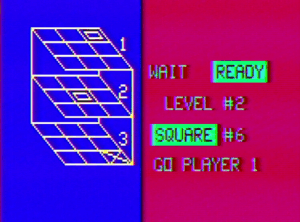
As far as I can tell, this is almost the only digital rendition of this game on a console at the time save for one other version. In April 1981, L&M Software published a 3x3x3 version of 3-D Tic Tac Toe using Bally BASIC for the Professional Arcade console. This version has no computer opponent and simply is a vehicle for two players to compete; strangely rather than highlighting which square you want to place your piece in, you instead have to select which level and then which square using a numerical code controlled using the spinner knob. Needless to say Shaw’s version comes across as more impressive than this version, with a single player option and more squares to work with, but this is a pretty serviceable version for being written using BASIC.
Try as I might, I couldn’t turn up any contemporary reviews of 3-D Tic-Tac-Toe, or even ones from the subsequent couple years. Given that it’s not the most exciting subject matter I could see how it would be overlooked where its fellow July releases wouldn’t be. The game was featured regularly in Atari’s own catalogs between 1980 and through 1982, being advertised as part of the company’s “classics line” before disappearing from the 1983 editions – though there is no evidence that the company discontinued the cart entirely, it at the very least took a back seat to their newer and more popular releases. In the Atari Corporation years the game only sold a little over 24,000 new copies solely in 1987 and 1988.
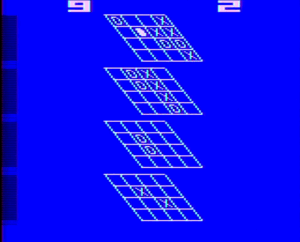
But even if this is Carol Shaw’s least impressive and popular title, it’s still a feat of programming to produce a cart with such a strong AI opponent in two kilobytes of cartridge space. Her skills at translating real-world games will show up again later in 1980 with the similarly impressive Video Checkers cartridge, but in the meantime, 3-D Tic-Tac-Toe fits perfectly into the what you’d expect from a VCS game: simple enough to learn, quick to play a game, and definitely tricky to master.
Sources:
The Carol Shaw papers, Strong Museum of Play
Preserving Carol Shaw’s Polo, Shannon Symonds, ROMchip, December 2019
Carol Shaw: Atari’s First Female Video Game Developer, Benj Edwards, Vintage Computing and Games, Oct. 12, 2011
Atari Corp. 2600 Sales figures, 1986-1990
Mathematical Games, Martin Gardner, Scientific American, January 1979
Qubic: 4x4x4 Tic-Tac-Toe, Oren Patashnik, Mathematics Magazine, Vol. 53 Issue 4, September 1980
Joe Weisbecker papers, Hagley Museum & Library
The Sarnoff Collection, The College of New Jersey
101 BASIC Computer Games, David Ahl, 1973
The Fairchild Channel F Panel, Classic Gaming Expo 2004
Polo, Atariprotos.com
The Priesthood at Play: Computer Games in the 1950s, Alex Smith, They Create Worlds, Jan. 22. 2014
Release date sources:
3-D Tic-Tac-Toe, July 1980 (Atari VCS) – Source: Chicago Heights Star, June 29 1980; New York Daily News, July 31, 1980; Post Crescent, July 31 1980
3-D Tic Tac Toe, April 1981 (Bally BASIC) – Source: Arcadian, April 15 1981; BASIC Express, May/June 1981
Tic-Tac-Toe/Shooting Gallery/Doodle/Quadradoodle, November 1976 (Channel F) – Source: Weekly Television Digest, October 25 1976; Channel F launch brochure

1 thought on “3-D Tic-Tac-Toe – July 1980”